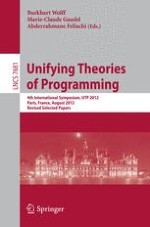2013 | Buch
Unifying Theories of Programming
4th International Symposium, UTP 2012, Paris, France, August 27-28, 2012, Revised Selected Papers
herausgegeben von: Burkhart Wolff, Marie-Claude Gaudel, Abderrahmane Feliachi
Verlag: Springer Berlin Heidelberg
Buchreihe : Lecture Notes in Computer Science
